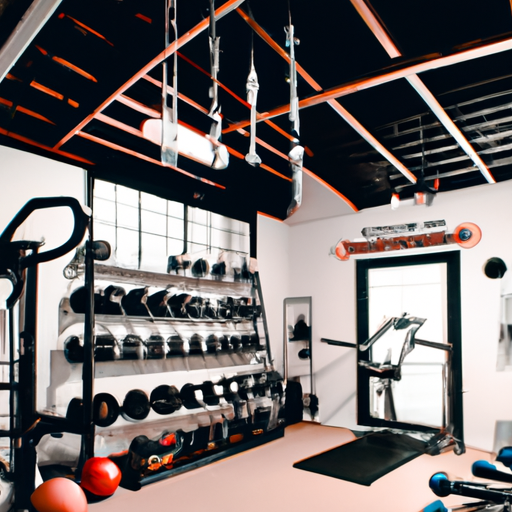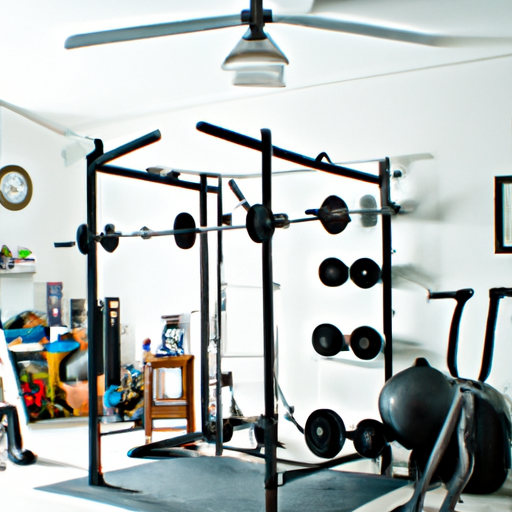Have you ever considered setting up a home gym but weren’t sure how much space you would need? Well, wonder no more! In this article, we will explore the ideal amount of space required to create a functional home gym. Whether you have a spare room or just a corner of your living space, we will provide you with some valuable insights and tips to help you maximize your workout area. So, get ready to turn any space into your own personal fitness haven!
Choosing the Right Space
Dedicated Room or Multi-purpose Room?
When creating a home gym, the first decision you need to make is whether you want to dedicate an entire room to your fitness pursuits or if you prefer a multi-purpose room. Both options have their pros and cons, so consider your specific needs and priorities.
A dedicated room offers the advantage of privacy and focus. It allows you to fully immerse yourself in your workout without any distractions. On the other hand, if space is limited, a multi-purpose room can be a practical solution. You can work out while also using the space for other activities like yoga, Pilates, or even as a home office.
Consider Ceiling Height
Ceiling height is an important factor to consider when setting up a home gym. Ideally, you’ll want a space with a ceiling height of at least 8 feet to accommodate most fitness equipment. This ensures that you have enough room to perform exercises without any restrictions.
If you plan on incorporating equipment such as a treadmill or a pull-up bar, it’s crucial to measure the distance from the floor to the ceiling to ensure there is sufficient vertical clearance. Remember to account for your own height and any additional height requirements for specific exercises or equipment.
Flooring Options
Choosing the right flooring for your home gym is not only a matter of aesthetics but also functionality and safety. There are several flooring options available, each with its own benefits.
Carpet may seem like a soft and comfortable choice, but it can be detrimental to your workouts. It can cause instability and hinder exercises that require steady footing. Hardwood floors, on the other hand, provide a solid and durable surface, but they can be slippery and pose a risk of injury.
Rubber flooring is a popular choice for home gyms due to its shock-absorbing properties. It provides cushioning and prevents damage to your equipment in case of accidental drops. Additionally, it offers excellent traction, reducing the risk of slips and falls.
Ventilation and Lighting
Proper ventilation is essential for any home gym. Choosing a space with good airflow helps prevent overheating and ensures a comfortable and enjoyable workout experience. If your chosen space doesn’t have adequate natural ventilation, consider installing fans or an air conditioning system to keep the air circulating.
In terms of lighting, opt for a space with ample natural light if possible. Natural light creates an energizing and uplifting atmosphere, making your workouts more enjoyable. When natural light is not sufficient, invest in adequate artificial lighting to brighten up the space. Avoid harsh and glaring lights that may strain your eyes during workouts.
Determining the Equipment
Cardiovascular Equipment
Cardiovascular exercise is an integral part of any fitness routine. When setting up your home gym, consider including cardiovascular equipment such as treadmills, stationary bikes, elliptical trainers, or rowing machines.
Treadmills are versatile machines that allow for walking, jogging, or running indoors regardless of the weather outside. Stationary bikes provide a low-impact workout option and come in various styles, including upright and recumbent bikes. Elliptical trainers offer a full-body workout, targeting both the upper and lower body. Rowing machines engage multiple muscle groups, providing an effective cardiovascular and strength training workout.
Choose the cardiovascular equipment that aligns with your fitness goals and preferences. Consider factors such as space requirements, budget, and the features and functionalities that best suit your needs.
Strength Training Equipment
Strength training helps build muscle, increase strength, and improve overall body composition. When selecting strength training equipment for your home gym, focus on versatile and essential pieces.
Dumbbells and adjustable weight sets are versatile options that allow you to perform a wide range of exercises targeting different muscle groups. Resistance bands are portable and inexpensive alternatives that provide resistance for strength training exercises. Pull-up bars can be mounted on a wall or doorway and offer a challenging upper body workout.
If you have the space and budget, consider investing in a weight bench and a power rack or a Smith machine. These pieces of equipment expand your strength training options, allowing for exercises such as bench presses, squats, and deadlifts.
Additional Accessories
In addition to cardiovascular and strength training equipment, there are various accessories that can enhance your home gym experience. Stability balls, exercise mats, and foam rollers are excellent for core workouts, stretching, and recovery.
Resistance bands, kettlebells, jump ropes, and medicine balls are versatile accessories that add variety to your workouts. They provide opportunities for functional movements, high-intensity interval training, and targeted muscle activation.
Consider your fitness goals and preferences when selecting additional accessories for your home gym. Take into account the available space and ensure that the accessories you choose complement your existing equipment.
Storage Solutions
To maximize space and keep your home gym organized, invest in adequate storage solutions. Equipment racks or shelves can hold dumbbells, kettlebells, and other small accessories. Wall-mounted racks can hold resistance bands, jump ropes, and yoga mats.
If space allows, consider installing a sturdy pegboard where you can hang and store various equipment and accessories. Modular storage systems with adjustable shelves and cabinets provide flexibility and adaptability to your changing needs.
Keeping your equipment and accessories properly organized not only creates a visually appealing space but also improves safety by reducing the risk of tripping over clutter.

Calculating Space Requirements
Minimum Space for Cardiovascular Equipment
When determining the space required for cardiovascular equipment, start by measuring the dimensions of the equipment you plan on including. Allow a minimum clearance space of 2 feet around each machine to ensure safe movement.
For example, if your treadmill measures 6 feet in length and 3 feet in width, you would need a minimum space of 10 feet by 7 feet to accommodate the machine comfortably. Repeat this process for each piece of cardiovascular equipment you plan on incorporating.
Recommended Space for Strength Training Equipment
Strength training exercises often require more space due to the range of motion involved. To determine the recommended space for strength training equipment, consider the size of the equipment and the movements you’ll be performing.
For a weight bench, allow approximately 4 feet of space on each side to account for movements such as barbell presses or dumbbell flyes. Power racks or Smith machines typically require a space of approximately 8 feet by 8 feet to allow for exercises such as squats and lunges.
Remember to consider your own height and range of motion when calculating the space required for strength training equipment. Leave enough room to move without any restrictions or risk of injury.
Additional Space for Flexibility and Mobility Exercises
Flexibility and mobility exercises play a crucial role in maintaining overall fitness and preventing injuries. Ensure that you have enough space to comfortably perform exercises such as yoga, Pilates, and stretching.
Allow a minimum of 6 feet by 6 feet of open floor space for these activities. This space will provide room for movements such as standing poses, mat work, and dynamic stretches. Consider investing in an exercise mat to provide cushioning and support during floor-based exercises.
Considering Safety Measures
Clearance Space around Equipment
Safety should always be a top priority in your home gym. Providing adequate clearance space around equipment not only prevents accidents but also allows for proper form and full range of motion during exercises.
Ensure there is enough space to comfortably navigate around and between equipment. Clear paths and walkways by removing obstacles or other items that may impede movement. Consider marking the floor with colored tape or mats to clearly define workout areas and walkways.
Flooring Safety Features
Choosing the right flooring is crucial for ensuring safety in your home gym. Rubber flooring is an excellent choice as it provides grip and shock absorption, reducing the risk of slips and injuries. Look for flooring with a textured surface to further enhance traction.
If you opt for hardwood or laminate flooring, consider adding non-slip mats or rugs in areas where there may be excessive foot traffic or potential for moisture accumulation. These safety measures provide additional grip and prevent accidents caused by slippery surfaces.
Safety Measures for Heavy Equipment
If your home gym includes heavy equipment such as a weight bench or a power rack, take extra precautions to ensure stability and prevent accidents.
Anchor heavy equipment to the floor or wall to prevent tipping or shifting during use. Use safety catches or spotter arms when performing exercises with free weights to catch the weight in case of muscle fatigue or loss of control.
Inspect your equipment regularly for any signs of wear or damage, and replace or repair as needed. Follow proper maintenance procedures and safety guidelines provided by the manufacturer for each piece of equipment.
By considering safety measures, you provide yourself with a secure and worry-free environment in which to achieve your fitness goals.
Creating a functional home gym requires thoughtful planning and consideration. By choosing the right space, determining the equipment that suits your needs, calculating space requirements, and implementing safety measures, you are on your way to designing the perfect home gym. Remember to personalize your space based on your fitness goals, preferences, and available resources. With a dedicated and well-designed home gym, you’ll have the convenience and motivation to pursue your fitness journey at any time, right in the comfort of your own home.

